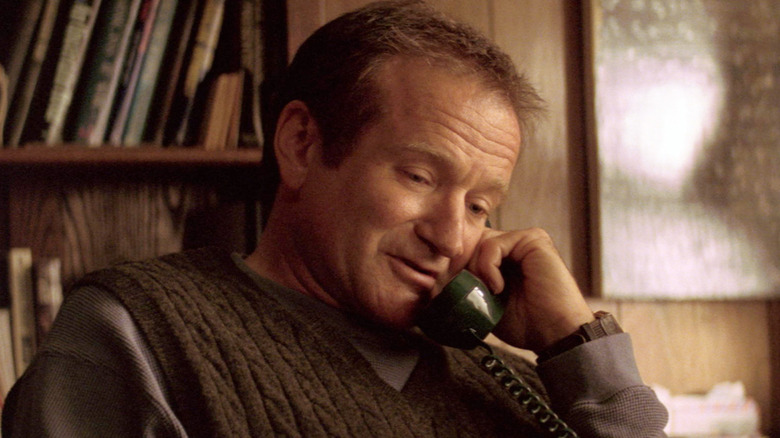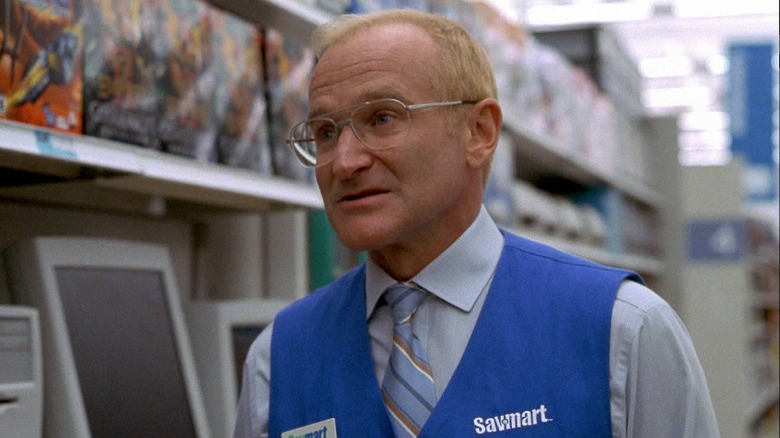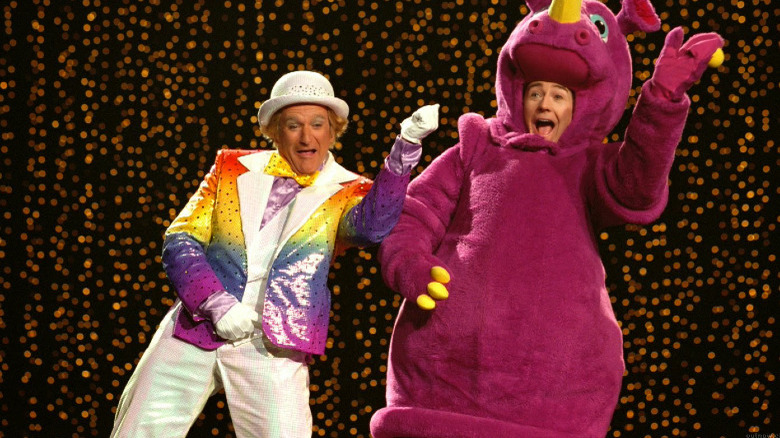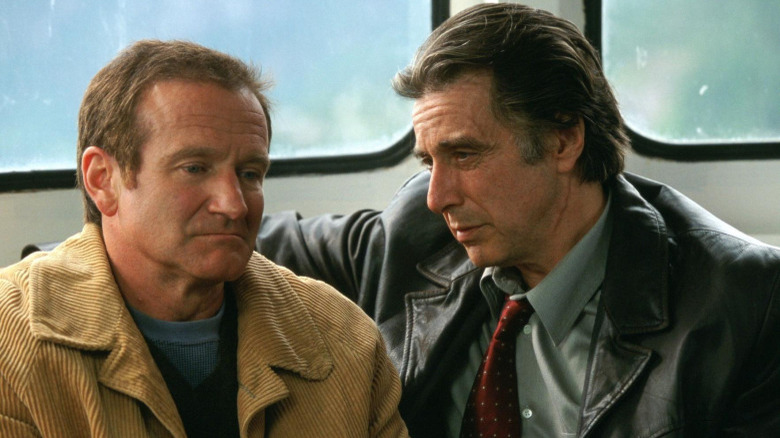Robin Williams' 'Triptych Of Evil' Showed Just How Dark The Actor Could Go
"Good Will Hunting" marked a turning point in Robin Williams' acting career. Besides snagging him his first and only Oscar win, it was perhaps the first time Williams had completely shed his energetic comedic persona on-screen. Indeed, there's nary a moment in director Gus Van Sant's 1997 drama where the actor bursts into some hyper-active form of pantomime. Even when his character in the film — a reticent therapist and psychology teacher — cracks a joke about sleeping with his patients or how his late wife would fart in her sleep, Williams delivers the punch-line in a fittingly dry, awkward manner.
In a way, "Good Will Hunting" was a prelude to what Williams would refer to in Dave Itzkoff's written 2018 biography "Robin" as his "triptych of evil." This was in referral to a period in the early aughts where the actor tackled three dark roles in a row, each of them a far cry from the kind-hearted, gentle souls he was better known for playing. "The idea of me doing this already starts people going, 'Wait a minute,'" Williams noted. "I've only done warm, nice people, and already it puts people in an interesting mode — off-balance, which was great."
What's really impressive about Williams' "triptych of evil" isn't that it proved he was capable of being genuinely unsettling and twisted on-screen. It's that he fully vanishes into these three roles, each of which is substantially unlike the others.
'All I did was take pictures'
The first of these films, 2002's "One Hour Photo," casts Williams as Seymour "Sy" Parrish, a technician at the one-hour photo lab in a large retail store who develops an unhealthy fixation with a family whose photos he develops. Sy is the polar opposite of what likely comes to mind when you think of Williams and not just because of his yellow-blonde hair. He rarely speaks or interacts with others — and when he does, he often trips over his own tongue. Also missing in the gleam Williams usually had in his eyes. There's no hint of real joy lurking behind his expressions, only unhappiness that spills over into anger as the movie progresses.
"One Hour Photo" served as the writing and directing debut for Mark Romanek, who went from helming stylishly bleak music videos for the likes of Nine Inch Nails to making, well, stylishly bleak films in the aughts (including "Never Let Me Go," a very good movie but also one that is sad enough to induce you into a state of depression after watching it). It was, to quote Itzkoff's book, his "homage to the paranoid character pieces of the 1970s he'd grown up admiring." Thanks to Williams, "One Hour Photo" comes as close any other throwback has to matching the upsetting vibes of a '70s classic like "Taxi Driver."
You know, for kids!
When you think about it, it's no real surprise Danny DeVito the director would specialize in making the type of pitch-dark, off-putting comedy films that DeVito the actor likes to star in (many of which are one and the same). This is also why his directorial efforts tend to inspire hot/cold reactions, none more so than 2002's "Death to Smoochy."
Directed by DeVito (who, yes, also co-stars), "Death to Smoochy" is a showbiz satire starring Williams as Randolph Smiley, the host of a popular kids TV show whose career goes down in flames when his vices — which include, but are not limited to, heavy drinking, accepting bribes from parents so their children can be on his show, and being an overall vile, unpleasant person — finally catch up to him. When Smiley is replaced by Sheldon Mopes (Edward Norton), a wide-eyed artist of virtue who plays a purple rhinoceros named Smoochy, it sends Smiley on a warpath for revenge.
If Williams, the stand-up comedian, tries to be chaotic good, his character in "Death to Smoochy" is almost purely chaotic evil. It's as though he's the nega-version of Williams the good-natured scamp, spouting derogatory insults and cracking mean-spirited jokes in-between threatening others with violence or tricking the naive Sheldon on-air into feeding cookies shaped like a certain piece of male anatomy to kids. Love it or hate it (Williams felt it was "a wonderful, nasty movie"), it's a film that shows a whole other side to Williams' dark persona than "One Hour Photo" does.
The devil on your shoulder
2002's "Insomnia" tends to be the most overlooked of Christopher Nolan's directorial efforts post-"Memento" and is the only one so far he didn't have a hand in writing. That it was also a remake of a critically-acclaimed 1997 Norwegian thriller movie of the same name likely didn't help its cause.
Wherever one ranks it among Nolan's other work, "Insomnia" is worth taking notice of simply for the chilling performance Williams gives as the film's villain. The movie stars Al Pacino as Will Dormer, a Los Angeles police detective who travels to a small town in Alaska to help investigate the murder of a local teen girl. Unable to sleep due to the never-ending daylight and stricken with guilt after he accidentally shoots and kills his partner, Will is further tormented by phone calls from the girl's killer, who he comes to learn is Williams' pulp crime author Walter Finch.
The thing that makes Williams so unnerving in "Insomnia" is how calmly and rationally he talks about his crime, as though he were discussing the weather. Williams' approach was partly informed by the research he did into serial killers for "One Hour Photo," in particular a Jeffrey Dahmer documentary where he was struck by how casually Dahmer described his heinous actions.
"The more normal and regular it seems, the creepier it is," as Williams put it, and he's right. There's neither a glimpse of empathy nor ounce of remorse in Finch when he's talking. It's his measured and collected manner (combined with a lack of mustache-twirling) that makes him the scariest character out of Williams' "triptych of evil." He's the devil on your shoulder, insisting it really is good to be bad.



